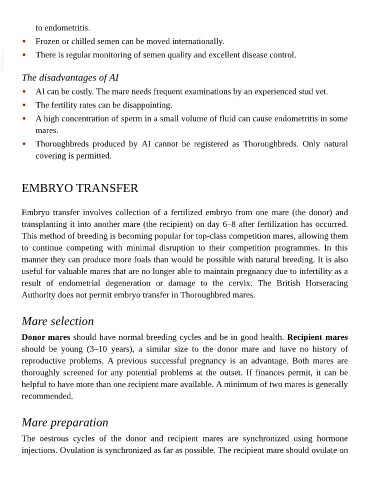Page 937 - The Veterinary Care of the Horse
P. 937
to endometritis.
• Frozen or chilled semen can be moved internationally.
VetBooks.ir • There is regular monitoring of semen quality and excellent disease control.
The disadvantages of AI
• AI can be costly. The mare needs frequent examinations by an experienced stud vet.
• The fertility rates can be disappointing.
• A high concentration of sperm in a small volume of fluid can cause endometritis in some
mares.
• Thoroughbreds produced by AI cannot be registered as Thoroughbreds. Only natural
covering is permitted.
EMBRYO TRANSFER
Embryo transfer involves collection of a fertilized embryo from one mare (the donor) and
transplanting it into another mare (the recipient) on day 6–8 after fertilization has occurred.
This method of breeding is becoming popular for top-class competition mares, allowing them
to continue competing with minimal disruption to their competition programmes. In this
manner they can produce more foals than would be possible with natural breeding. It is also
useful for valuable mares that are no longer able to maintain pregnancy due to infertility as a
result of endometrial degeneration or damage to the cervix. The British Horseracing
Authority does not permit embryo transfer in Thoroughbred mares.
Mare selection
Donor mares should have normal breeding cycles and be in good health. Recipient mares
should be young (3–10 years), a similar size to the donor mare and have no history of
reproductive problems. A previous successful pregnancy is an advantage. Both mares are
thoroughly screened for any potential problems at the outset. If finances permit, it can be
helpful to have more than one recipient mare available. A minimum of two mares is generally
recommended.
Mare preparation
The oestrous cycles of the donor and recipient mares are synchronized using hormone
injections. Ovulation is synchronized as far as possible. The recipient mare should ovulate on

